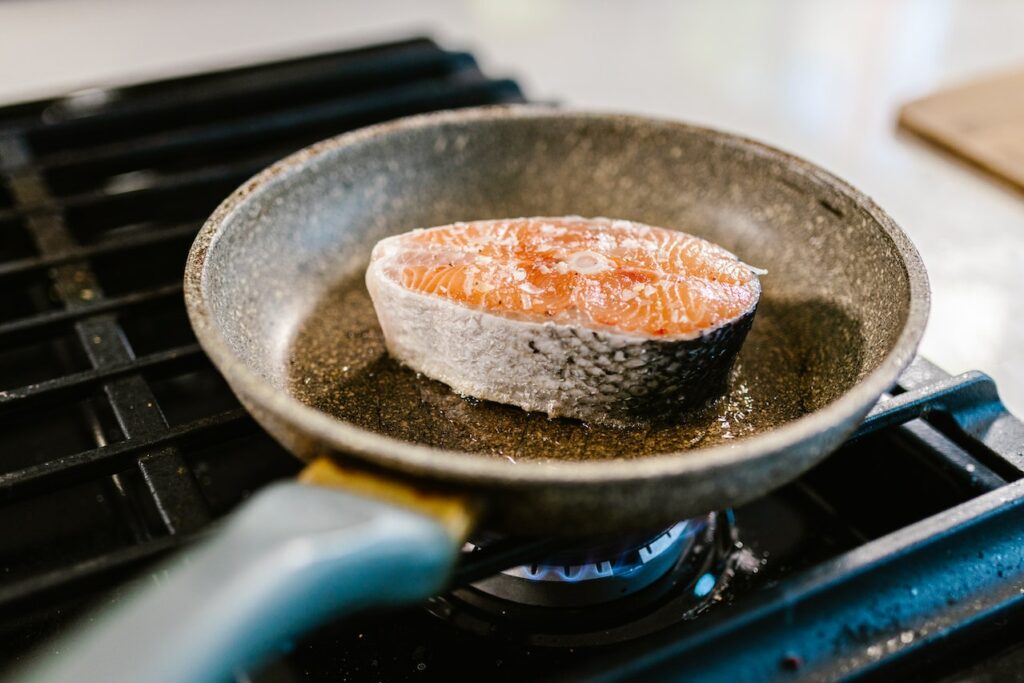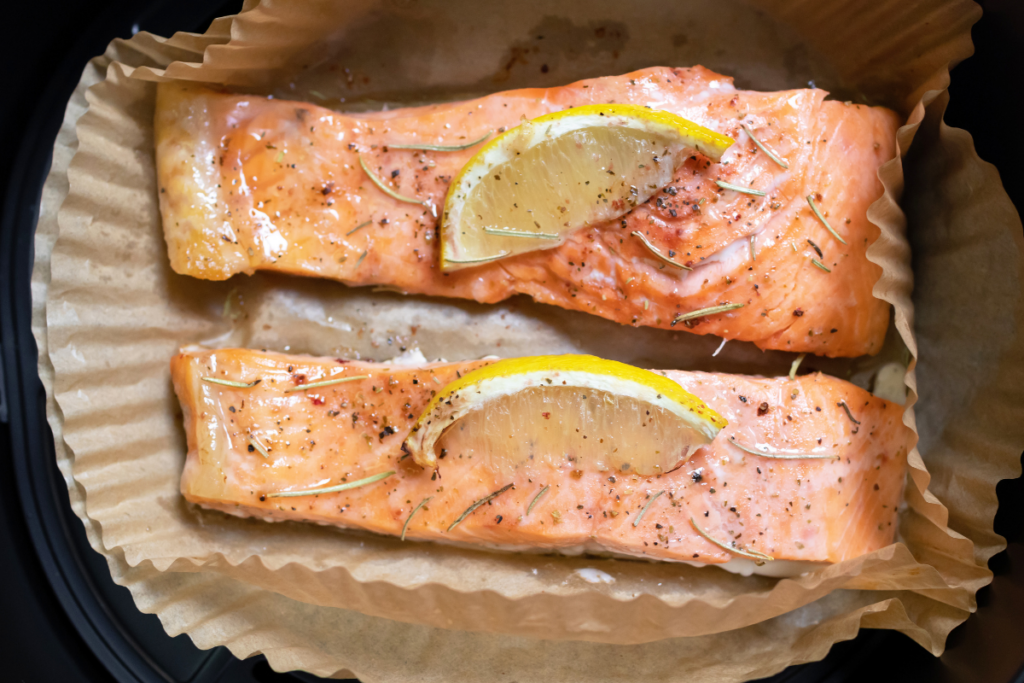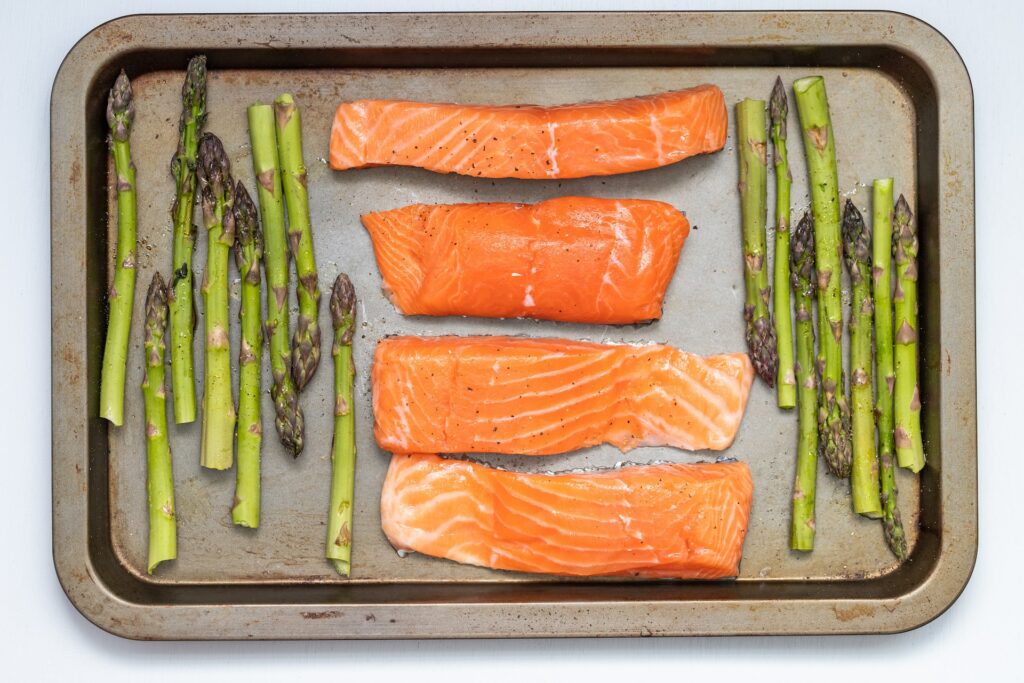Do you ever ask what is the white stuff that comes out salmon when cooking?
If you’re wondering what that white stuff is, you’re not alone.
The white substance that comes out of salmon is called albumin.
Albumin is a protein that is naturally found in salmon and other foods like eggs, beef, and milk.
It is a liquid protein that solidifies when the fish is cooked.
As the muscle fibers in the salmon contract under heat, the albumin is pushed to the surface of the fish, where it becomes thick and white.
The higher the heat, the more albumin is released, resulting in more of the white substance on the surface of the fish.
While it may not look very appetizing, the white substance is safe to eat and won’t affect the taste or quality of the fish.
In fact, salmon is a great source of protein and omega-3 fatty acids, making it a healthy addition to your diet.
Now that you know what the white stuff is, you can confidently cook your salmon without any concerns.
What Is The White Stuff That Comes Out Of Salmon?
If you have ever cooked salmon, you may have noticed a white substance coming out of the fish.

This substance is called albumin and is a natural protein found in salmon.
Albumin is a water-soluble protein that is found in the muscle fibers of salmon.
When the fish is cooked, the muscle fibers contract and the albumin is pushed out to the surface of the fish.
The albumin then coagulates and solidifies, forming the white substance that you see.
The amount of albumin that comes out of salmon depends on how it is cooked.
Higher cooking temperatures and shorter cooking times will result in more albumin being pushed ou.
Lower temperatures and longer cooking times will result in less albumin.
While albumin is completely safe to eat, it can affect the texture and appearance of the salmon.
It can make the fish look dry and overcooked, and it can also make the texture of the fish rubbery.
To minimize the amount of albumin that comes out of your salmon, you can try cooking it at a lower temperature for a longer period of time.
You can also try brining the salmon before cooking it, as the salt in the brine can help to break down the muscle fibers and prevent the albumin from being pushed out.
In summary, the white substance that comes out of salmon when it is cooked is called albumin, and it is a natural protein found in the fish.
While it is safe to eat, it can affect the texture and appearance of the salmon.
By cooking the fish at a lower temperature for a longer period of time or brining it before cooking, you can minimize the amount of albumin that is released.
Causes Of Albumin Coagulation
When cooking salmon, you may notice a white substance oozing out of the fish.
This substance is albumin, a type of protein found in fish, eggs, beef, and milk.
The coagulation of albumin is a natural process that occurs when the fish is cooked.
Here are some factors that contribute to albumin coagulation:
Cooking Temperature
Cooking salmon at high temperatures can cause albumin to coagulate and push out of the fish.
The higher the cooking temperature, the more albumin will be released.
To prevent this, cook salmon at a lower temperature for a longer time.
This will give the albumin time to coagulate and solidify within the fish, rather than being forced out.
Salmon Quality
The quality of the salmon can also affect the amount of albumin that is released during cooking.
Fresh, high-quality salmon will release less albumin than lower-quality salmon.
If you are noticing a significant amount of albumin coming out of your salmon, try purchasing a higher-quality fish.
Marinating Process
Marinating salmon before cooking can also affect the amount of albumin that is released.
A marinade that is high in salt can cause the fish to release more albumin during cooking.
To prevent this, use a marinade that is low in salt and acid.
You can also try using a dry rub instead of a marinade.
Overall, albumin coagulation is a natural process that occurs when cooking salmon.
By cooking at a lower temperature, using high-quality salmon, and using a low-salt marinade, you can minimize the amount of albumin that is released during cooking.

Preventing Albumin Coagulation
If you’re tired of seeing that unsightly white stuff seeping out of your salmon, there are a few things you can do to prevent it from happening.
Here are some tips to help you avoid albumin coagulation and keep your salmon looking and tasting great.
Proper Cooking Techniques
One of the most important things you can do to prevent albumin coagulation is to cook your salmon properly.
Overcooking your fish can cause the muscle fibers to contract, which in turn squeezes out the albumin.
To avoid this, try cooking your salmon gently at a low temperature.
You can also try cooking it in a sous vide machine, which will help keep the albumin inside the fish.
Choosing High-Quality Salmon
The quality of your salmon can also play a role in albumin coagulation. Look for salmon that is fresh and has been handled properly.
Avoid salmon that has been frozen and thawed multiple times, as this can cause the muscle fibers to break down and release more albumin.
If possible, try to buy wild-caught salmon instead of farmed salmon, as wild salmon tends to have less albumin.
Effective Marinating Methods
Marinating your salmon can also help prevent albumin coagulation.
The acid in the marinade can help break down the muscle fibers and keep the albumin from being squeezed out.
However, it’s important to choose the right type of marinade.
Avoid marinades that are high in salt, as this can actually cause more albumin to be released.
Instead, try using a marinade that is high in acid, such as lemon juice or vinegar.
By following these tips, you can help prevent albumin coagulation and keep your salmon looking and tasting great.
Remember to cook your salmon gently, choose high-quality fish, and use an effective marinade to keep the albumin inside the fish where it belongs.

Key Takeaways
If you’ve ever cooked salmon, you may have noticed a white substance appearing on the surface of the fish.
This white stuff is called albumin, a protein that is naturally found in salmon.
Here are some key takeaways about albumin and how to reduce it:
- Albumin is safe to eat: Despite its unappetizing appearance, albumin is safe to consume and does not affect the taste or quality of the fish.
- Cooking temperature affects albumin: The higher the cooking temperature, the more albumin will seep out of the salmon.
- To reduce albumin, try cooking your salmon at a lower temperature for a longer period of time.
- Acidic marinades can help: Marinating salmon in an acidic mixture, such as lemon juice or vinegar, can help reduce the amount of albumin that appears during cooking.
- Removing the skin can reduce albumin: If you’re not a fan of the white stuff, removing the skin before cooking can help reduce the amount of albumin that appears on the surface of the fish.
- Fresh salmon has less albumin: Fresher salmon has less albumin than older fish, so try to purchase your salmon as fresh as possible.
While albumin may not be the most attractive aspect of cooked salmon, it is safe to eat and can be reduced by adjusting your cooking methods or using acidic marinades.
